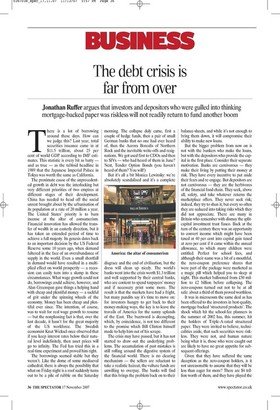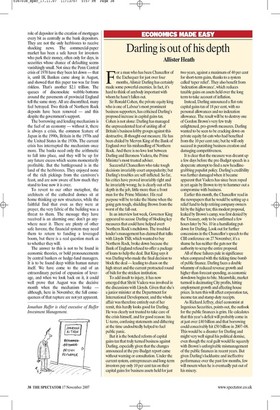The debt crisis is far from over
Jonathan Ruffer argues that investors and depositors who were gulled into thinking mortgage-backed paper was riskless will not readily return to fund another boom There is a lot of borrowing around these days. How can we judge this? Last year, total securities issuance came in at $11.5 trillion, about 25 per cent of world GDP according to IMF estimates. This statistic is every bit as batty — and as true — as the tabloid headline in 1989 that the Japanese Imperial Palace in Tokyo was worth the same as California.
The proximate cause of the unprecedented growth in debt was the interlocking but very different priorities of two empires at different stages of their development. China has needed to head off the social unrest brought about by the urbanisation of its population at a rate of 20 million a year. The United States' priority is to burn incense at the altar of consumerism. Financial innovation has allowed the transfer of wealth in an easterly direction, but it has taken an extended period of time to achieve a full majesty. Its genesis dates back to an important decision by the US Federal Reserve some 10 years ago, when demand faltered in the face of an overabundance of supply in the world. Even a small shortfall in demand would have resulted in a multiplied effect on world prosperity — a recession can easily turn into a slump in these circumstances. What wage growth could not do, borrowings could achieve, however, and Alan Greenspan gave things a helping hand with cheap and plentiful money — a sackful of grit under the spinning wheels of the economy. Money has been cheap and plentiful ever since. The intention, of course, was to wait for real wage growth to resume — but the nonplussing fact is that, over the last decade, it hasn't for the great majority of the US workforce. The Swedish economist Knut Wicksel once observed that if you keep interest rates below their natural level indefinitely, then asset prices will go to infinity. The Fed has tried this in a real-time experiment and proved him right.
The borrowings seemed stable but they weren't. Like the dome of some mediaeval cathedral, there is always the possibility that what on Friday night is a roof suddenly turns out to be a pile of rubble on the Saturday morning. The collapse duly came, first a couple of hedge funds, then a pair of small German banks that no one had ever heard of, then the Aurora Borealis of Northern Rock and the inevitable write-offs and resignations. We got used first to CDOs and then to SIVs — who had heard of them in June? Next, Tender Option Bonds (you haven't heard of them? You will!) But it's all a bit Monica Lewinsky: we're absolutely scandalised and it's a complete disgrace and the end of civilisation, but the dress will clean up nicely. The world's banks went into the crisis worth $1.3 trillion and well supported by their central banks, who are content to spend taxpayers' money and if necessary print some more. The result is that the markets have had a fright, but many pundits say it's time to move on: for investors hungry to get back to their money-making ways, the key is to leave the travails of America for the sunny uplands of the East. The buzzword is decoupling, which, by coincidence, is not too different to the promise which Bill Clinton himself made to help him out of his scrape.
The crisis may have passed, but it has not started to draw out the underlying problems. The accumulation of past mistakes is still rolling around the digestive system of the financial world. There is no clearing mechanism — the sellers are reluctant to take a realistic haircut, the vulture funds are unwilling to overpay. The banks will find that this brings the problem back on to their balance-sheets, and while it's not enough to bring them down, it will compromise their ability to make new loans.
But the bigger problem from now on is not with the bankers who make the loans, but with the depositors who provide the capital in the first place. Consider their separate motivation. Banks are carnivorous — they make their living by putting their money at risk. They have every incentive to put aside their fears and re-engage. But depositors are not carnivorous — they are the herbivores of the financial food chain. They seek, above all, safety, and take whatever returns the marketplace offers. They never seek risk; indeed, they try to shun it, but every so often they are seduced into taking risks which they did not appreciate. There are many in Britain who remember with dismay the splitcapital investment trust fiasco. Back at the turn of the century there was an opportunity to convert income which might have been taxed at 40 per cent into capital gain taxed at zero per cent if it came within the annual allowance, to which many children were entitled. Perfect for school fees, and although their name was a bit of a mouthful, the zero-coupon preference shares that were part of the package were marketed as a magic pill which helped you to sleep at night. This market ballooned from £50 million to £2 billion before collapsing. The zero-coupons turned out not to be at all safe: about a third of them proved worthless.
It was in microcosm the same deal as has been offered to the investors in best-quality, mortgage-backed 'structured products'. The shock which hit the school-fee planners in the summer of 2002 has, this summer, hit the holders of Triple-A-rated structured paper. They were invited to believe, technicalities aside, that such securities were riskless. They were not, and human nature being what it is, those who were caught out are likely to have no great appetite for subsequent offerings.
Given that they have suffered the same deception as the zero-coupon holders, is it not unreasonable to assume that they will be less than eager for more? There are $4 trillion worth of them, and they have played the role of depositor in the creation of mortgages every bit as centrally as the bank depositors. They are not the only herbivores to receive shocking news. The commercial-paper market has been a safe haven for investors who park their money, often only for days, in securities whose chance of defaulting seems vanishingly small. Not since the Penn Central crisis of 1970 have they been let down — that is, until IK Banken came along in August, and showed that this paper too was far from risldess. That's another $2.1 trillion. The queues of disconsolate wobble-bottoms around the pavements of provincial England tell the same story. All are discomfited, many feel betrayed. Two thirds of Northern Rock deposits have been removed — and this despite the government's support.
The borrowing and lending mechanism is the fuel of an economy — without it, there is always a crisis, the common feature of Japan in the 1990s, Britain in the 1970s and the United States in the 1930s. The current crisis has interrupted the mechanism once more. The banks need only the arithmetic to fall into place, and they will be up for any future excess which seems momentarily profitable. But the battleground is in the land of the herbivores. They enjoyed none of the rich pickings from the carnivore's feast, and are now aware of how much they stand to lose now it is over.
To revert to our other metaphor, the architects of the cathedral domes sit at home thinking up new structures, while the faithful find that even as they were at prayer, the very fabric of the building was a threat to them. The message they have received is an alarming one: don't go anywhere near it. There are plenty of other safe havens; the financial system may need them to return to funding a leveraged boom, but there is a real question mark as to whether they will.
The answer to this is not to be found in economic theories, or bold pronouncements by central bankers or hedge-fund managers. It is to be found deep within human nature itself. We have come to the end of an extraordinary period of expansion of leverage, and when we look back on it, it could well prove that August was the decisive month when the mechanism broke — although, here in November, the full consequences of that rupture are not yet apparent.





































































 Previous page
Previous page